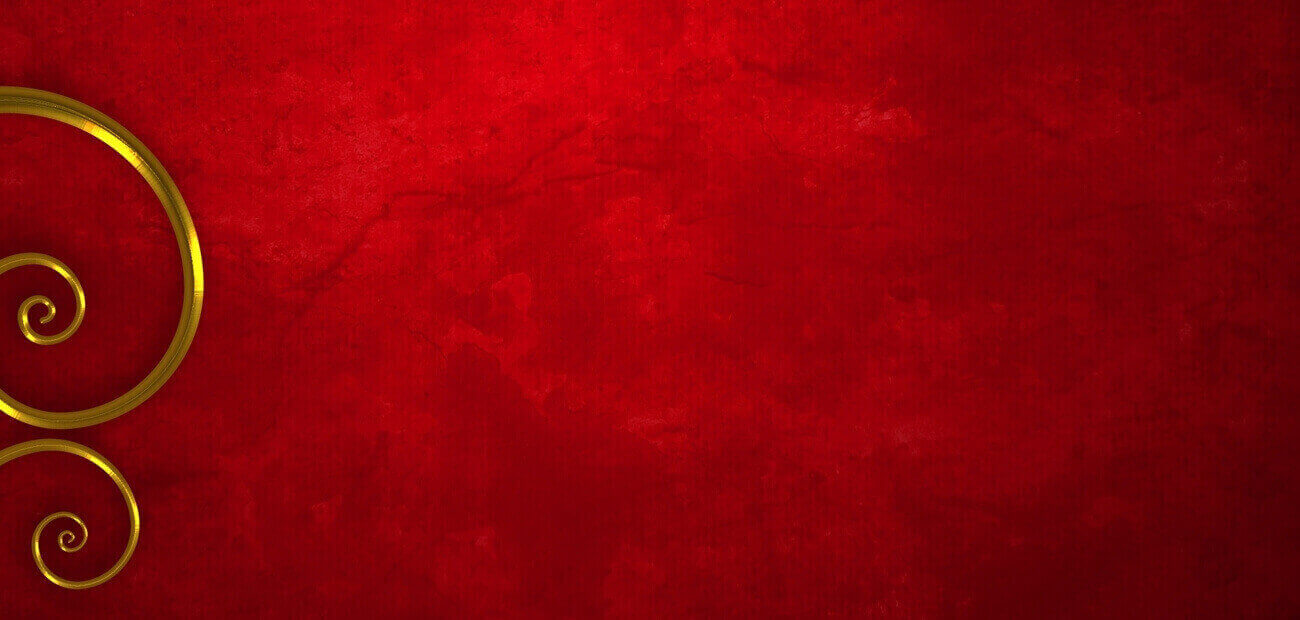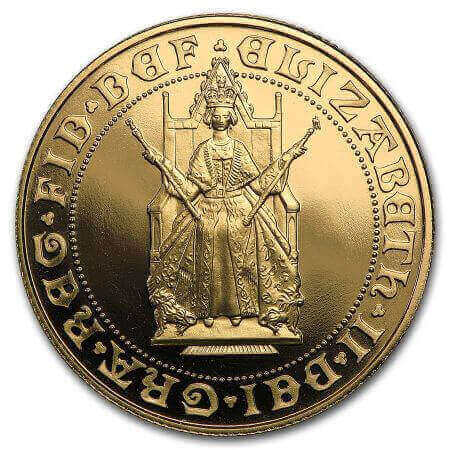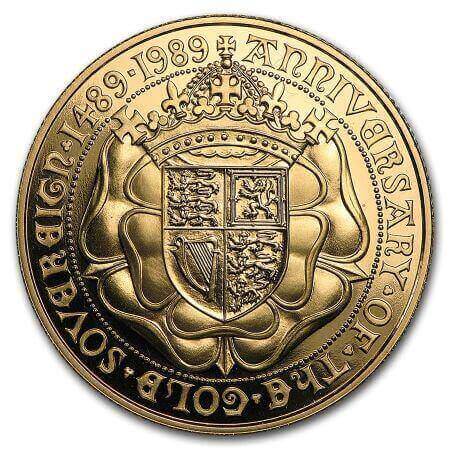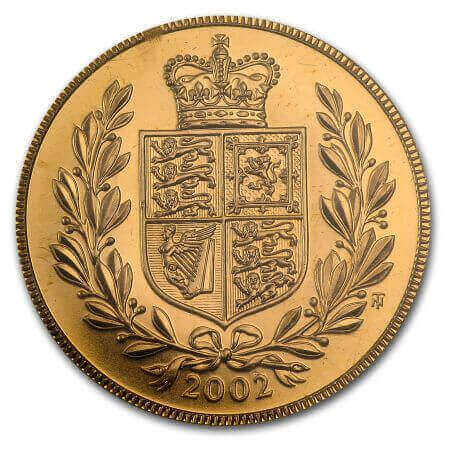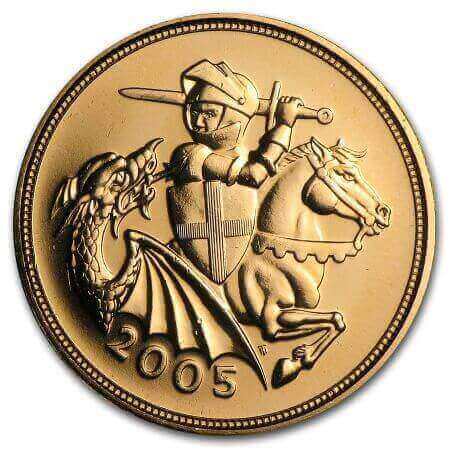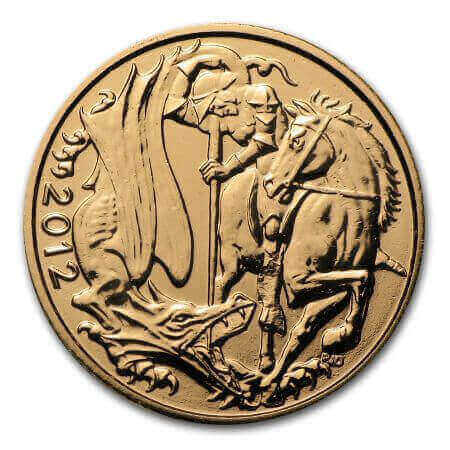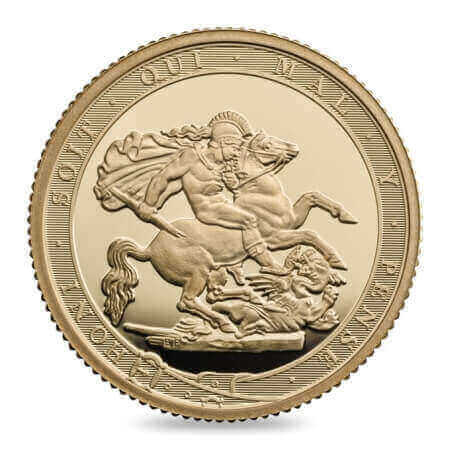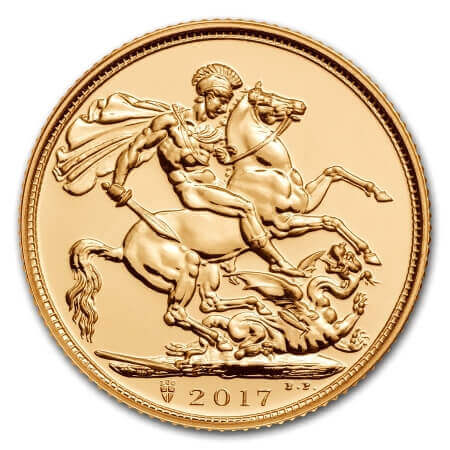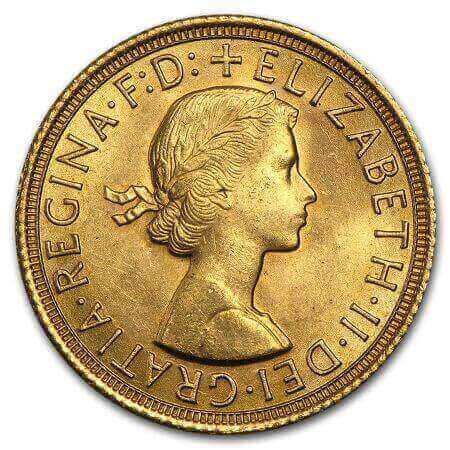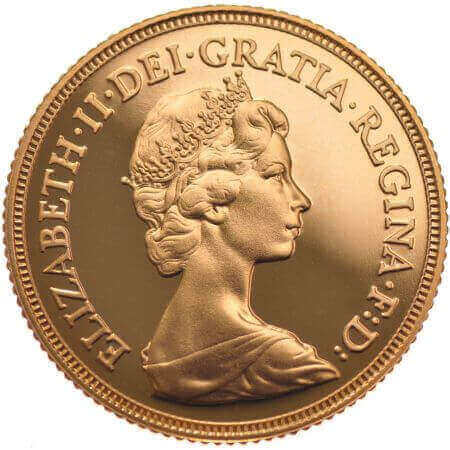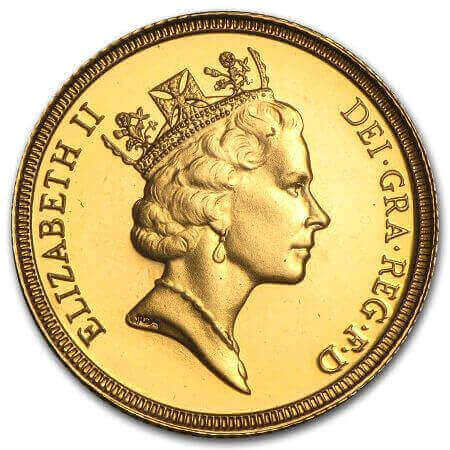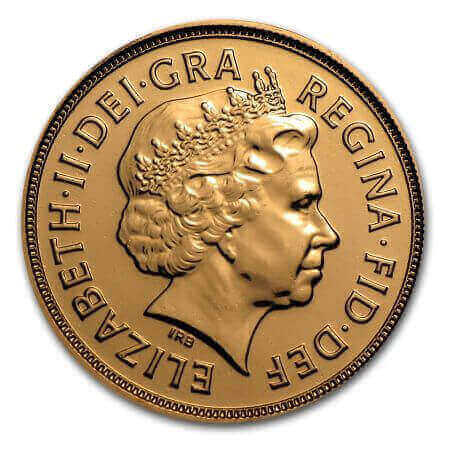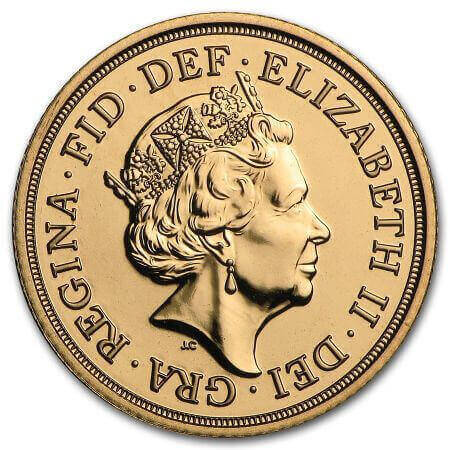British Gold Sovereign Coins

 Gold Sovereigns - recognized worldwide for their famed design and long history
Gold Sovereigns - recognized worldwide for their famed design and long history
When you buy gold in the form of Gold Sovereigns, you buy a piece of history. Their history reaches back to the year 1817 for the modern version of the Sovereign and even further for the historic original Sovereign. The coins are minted in their current form since 1957 by Britain's renowned Royal Mint. The standard reverse design of the Sovereign gold coins shows St. George slaying the dragon. It makes the Gold Sovereign one of the world's most recognizable coins.
The British Gold Sovereign coins are minted out of 91.67% pure gold. Twenty-two karat purity gold like that is sometimes also referred to as crown gold, which is a more than fitting name in the case of the Gold Sovereign coin. Buyers of the coins can choose between three different finishes as the Royal Mint produces them as regular bullion coins as well as with brilliant uncirculated (BU) and proof finishes. According to the Royal Mint, its brilliant uncirculated (BU) gold coins are minted to a higher production standard than regular bullion coins.
British Gold Sovereigns are sold individually and in mint tubes of 25 coins. The coins are legal tender in the UK (which makes them exempt from the payment of Capital Gains Tax) and their purity, weight and metal content is guaranteed by the British government. The Royal Mint currently produces Sovereigns in the denominations of 5 Pounds (Five Sovereign or Quintuple-Sovereign), 2 Pounds (Double-Sovereign), 1 Pound (Sovereign), 0.5 Pounds (Half-Sovereign) and 0.25 Pounds (Quarter-Sovereign).
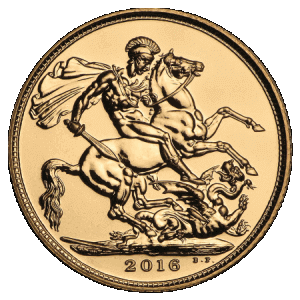
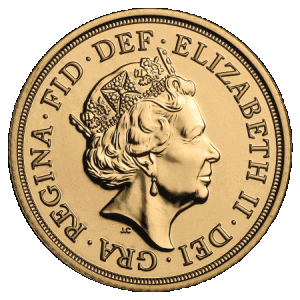
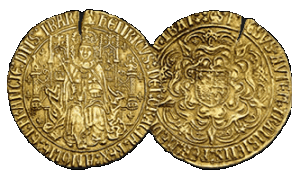
Coin Specifications
| Weight | Face Value | Purity | Diameter x Thickness |
|---|---|---|---|
| 1.1771 oz | £ 5 | 91.67% | 36.02 x 2.89 mm |
| 0.4708 oz | £ 2 | 91.67% | 28.4 x 2 mm |
| 0.2354 oz | £ 1 | 91.67% | 22.05 x 1.52 mm |
| 0.1177 oz | £ 0.5 | 91.67% | 19.3 x 1 mm |
| 0.0588 oz | £ 0.25 | 91.67% | 13.5 x 1.1 mm |
British Gold Sovereign Coin Designs
Gold Sovereign Coin Design
The obverse side of the coin depicts a portrait of Her Majesty Queen Elizabeth II. In March 2015, a switch was made from Ian Rank-Broadley's fourth official effigy of her majesty to Jody Clark's fifth portrait that shows an older Queen. Proof Sovereigns depict the fifth portrait since that date. Bullion and brilliant uncirculated Sovereigns depict the new fifth portrait since 2016. In the slideshow above, you can also see the first, second and third portrait of her majesty that appeared on Gold Sovereign coins since 1957. Starting with the Queen's fourth portrait, the artist's initials (IRB or J.C) appear below the image. The profile of her majesty that appears on the British Gold Sovereign coin can also be seen on the British Gold Lunar coins, British Gold Britannia coins and Queen's Beasts gold coins. Her majesty's name, "Dei Gra" and "Regina Fid Def" are engraved along the coin's edge. However, the respective official denomination is not engraved on the various Sovereign coins.
The standard reverse design of the British Gold Sovereign goes back all the way to 1817. It depicts St. George on a horse in the process of slaying a dragon. This classic design by the Italian engraver Benedetto Pistrucci makes the Sovereign one of the most recognizable coins. The year of mintage appears underneath the image. Since 1957, Pistrucci's design was only replaced in 1989, 2002, 2005 and 2012. The 2005 and 2012 editions of the Gold Sovereign depict modern interpretations of the "St. George slaying the dragon" theme. The 2002 Sovereign was dedicated to the Queen's 50th anniversary on the British throne and depicts a crowned shield and wreath. The 1989 coin was dedicated to the 500th anniversary of the historic Sovereign. It shows the crowned shield on top of a double rose and the inscription "1489 - 1989 Anniversary of the Gold Sovereign".
History of the British Gold Sovereign
In 1489, King Henry VII ordered the Royal Mint to produce a new and larger gold coin. The new half ounce coin out of 95.83% gold (23 carat) was called a Sovereign, possibly because it showed a portrait of the enthroned king on the obverse side. The depiction of the royal coat of arms on top of a double rose was meant to symbolise the new union between York and Lancaster after the War of the Roses. The gold content was reduced to 91.67% during the reign of King Henry VIII. This 22 carat gold is still referred to as crown gold today. The size of the Sovereign was repeatedly reduced but successive Tudor monarchs continued to have it minted until the year 1604.
Due to currency reforms after the Napoleonic wars, a new 20 Shilling gold coin was introduced in 1817 and given the old name of Sovereign. The revived Sovereign coin was not only lighter and smaller than the original Sovereign, it also featured a different design on the reverse side. The Italian engraver Benedetto Pistrucci designed the now famous image of St. George on horseback slaying a dragon. From 1825 to 1870, the Sovereign's reverse showed a conventional royal coat of arms though. Pistrucci's "St. George and the Dragon" design returned in 1871. Until 1887, Sovereign coins were minted with both the St. George and the royal shield design on the reverse side. Mintage of Sovereigns stopped in 1917. The coins were briefly minted again in 1925 when Winston Churchill tried to reintroduce the gold standard, but it was not until 1957 that more or less regular production resumed. No coins were produced in the years 1960 - 1961, 1969 - 1973, 1975 and 1977 and only proof Sovereigns were produced between 1983 and 1999. Since 2000, Great Britain Gold Sovereign coins are issued every year in the form of brilliant uncirculated bullion coins as well as proof coins. The Sovereigns minted in 1989 (Bernard Sindall's design of a crowned shield of the Royal Arms on a double Tudor rose for the Sovereign's 500th Anniversary), 2002 (shield of the Royal Arms for the Queen's Golden Jubilee by Timothy Noad), 2005 (modern interpretation of "St. George and the Dragon" by Timothy Noad) and 2012 (new depiction of "St. George and the Dragon" for the Queen’s Diamond Jubilee by Paul Day) feature different designs on their reverse sides instead of Pistrucci's original design.
Since 1817, portraits of nine successive British monarchs have appeared on the obverse side of the modern Sovereign coins. The first depicted monarch was George III whose portrait appeared from 1817 to 1820. His portrait was replaced by those of George IV (1821 - 1830), William IV (1831 - 1837), Queen Victoria (1838 - 1901), Edward VII (1902 - 1910), George V (1911 - 1932), Edward VIII (1937), George VI (1937) and Elizabeth II (since 1953). Some of those monarchs had their coin portraits changed throughout their reign.
The Royal Mint was not the only place where Sovereigns were minted in the past. The coins had also been minted in Melbourne (1872 - 1931, mint mark 'M'), Sydney (1855 - 1926, mint mark 'S'), Perth (1899 - 1931, mint mark 'P'), Bombay (1918, mint mark 'I'), Ottawa (1908 - 1919, mint mark 'C') and Pretoria (1923 - 1932, mint mark 'SA'). Interestingly, Sovereigns minted in Sydney between 1855 and 1870 had a special design but all other Sovereign coins minted at these branches of the Royal Mint were identical in design to the coins minted in London. Since 2013, Sovereign coins are also minted under license by the Indian/Swiss joint venture MMTC-PAMP in Delhi. The Sovereigns minted in India bear the mint mark 'I' but are otherwise identical to British Sovereign gold coins minted in the UK.
The Half-Sovereign was first produced under the reign of King Henry VIII in 1544. Production continued until 1604 and it was not until 1817 that the Half-Sovereign was reintroduced. Since 1893, St. George also appears on the Half-Sovereign, replacing the usual royal arms design. Half-Sovereigns continued to be produced until 1926. After that, only special proof issues for coronation years appeared until 1980. A staggering 2.5 million bullion Half-Sovereigns were minted in 1982. From 1983 until 1999, only proof Half-Sovereigns were minted. Since 2000, the coins are produced every year as brilliant uncirculated and proof coins.
The first Double-Sovereign coins were struck in 1485 for Henry VII and in 1553 for Edward VI. The first modern Double-Sovereign with the "St. George and the Dragon" design was struck in 1820 for George III as a pattern coin. Proof and circulation Double-Sovereigns were issued in the years 1823, 1887, 1893 and 1902. Only proof coins were issued in 1824, 1825, 1826, 1831, 1911 and 1937. Double-Sovereign gold coins are issued again in most years since 1980, often only as proof coins.
Quintuple-Sovereign coins were produced since 1820 (proof and uncirculated) in some years. Since 1984, Quintuple-Sovereigns are produced every year. The coins were also first made with brilliant uncirculated finishes that same year. Before 1984, they were only available as proof and uncirculated coins. The British Royal Mint created some confusion when it introduced a bullion version of the coins in 2000. Although these bullion coins are uncirculated as well, they are produced to a lower production standard than brilliant uncirculated coins.
The Quarter-Sovereign was first produced in 1853, but only as two different pattern coins (with different designs on their reverse side). In 2009, Quarter-Sovereigns were first issued by the Royal Mint bearing Pistrucci's design.
In order to celebrate the 200th anniversary of the reverse design of the modern British Sovereign gold coin in 2017, a special shield mint mark appears below the dragon on the coins from that year. On the 6th of February 2017, a limited mintage of 750 Sovereign coins was struck by the Royal Mint as a way to commemorate the Queen's Sapphire Jubilee that day. These limited edition coins (that look the same as 'regular' Sovereigns) are packaged in a special display box with a certificate of authenticity.
The 2017 proof Sovereigns are also unique in that they use Benedetto Pistrucci’s special garter design (see slideshow above) for the first time since 1820. That garter design had first been used on the Sovereign in 1817. It shows the St. George and the dragon design surrounded by a garter border with an old French inscription ("Honi soit qui mal y pense" which means "Shame be to him who thinks evil of it"). These words are the motto of the Order of the Garter. The 2017 proof Sovereigns also differ in that they show the mintage year on the obverse side for the first time since 1887.
Mintage Numbers
Mintage numbers of the modern Royal Mint Sovereigns (since 1957) vary wildly between 30,688 coins in 2004 and a whopping 9.1 million coins in 1979. Click here to see a table with detailed mintage numbers. The Royal Mint also published some mintage numbers online.
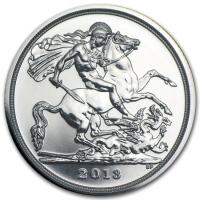
St. George and the Dragon silver coins
There are no official Silver Sovereigns. In 2013, the Royal Mint released silver coins (brilliant uncirculated) with the same design as the Sovereign coins though. These 1/2 oz "St. George and the Dragon" coins out of 99.9% silver have a face value of £ 20. The mintage limit of these legal tender coins was set at 250,000 pieces.
In addition to these silver bullion coins, the Royal Mint also produced 10,000 commemorative "St. George and the Dragon" £ 5 proof coins in 2013. These coins out of sterling silver (92.5% silver purity) were issued in order to commemorate the birth of Prince George in 2013.
The famous "St. George and the Dragon" design had also been used on British Silver Crown coins in the 1800's.
Proof Sets of the Gold Sovereign coins
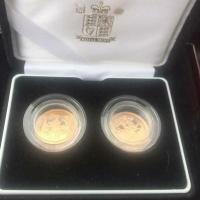
2 Coin Proof Set 2007 - 2009
total gold weight: 0.3531 oz
These sets were only released in the years 2007 (mintage: 818 sets), 2008 (804 sets) and 2009 (1,000 sets). The two included proof coins are the Sovereign and Half-Sovereign. The two coins are encapsulated and packaged in a presentation box. A numbered certificate is included for each coin.
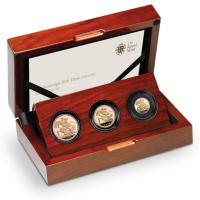
3 Coin Standard Proof Set since 2009
total gold weight: 0.4119 oz
Included in this set are the Sovereign, Half-Sovereign and Quarter-Sovereign. The coins are packaged in a wooden box with a numbered certificate of authenticity. These sets are issued since 2009 (first year the Quarter-Sovereign was issued) and annual mintage is limited to around 750 to 1,500 sets.
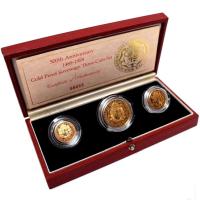
3 Coin Premium Proof Set
total gold weight: 0.8239 oz
A certificate of authenticity accompanies the Half-Sovereign, Sovereign and Double-Sovereign in this set that is issued since 1983. In 1984, it included a Quintuple-Sovereign instead of the Double-Sovereign. These sets are called 'Premium' since 2009 in order to distinguish them from the other 3 coin set above.
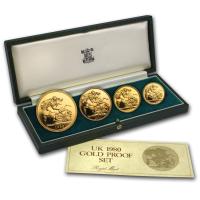
4 Coin Proof Set 1980 - 2008
total gold weight: 2.001 oz
Included are the Quintuple-Sovereign, Double-Sovereign (some years with commemorative design), Sovereign, Half-Sovereign and a certificate of authenticity. Gold-plated medallions were included as a bonus between 1990 and 2001. An additional silver medallion (Benedetto Pistrucci portrait) was included in 1993.
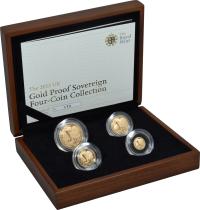
4 Coin Proof Set since 2009
total gold weight: 0.8827 oz
Since the 5 coin proof set (see below) was introduced in 2009, the 4 coin proof set includes the Double-Sovereign, Sovereign, Half-Sovereign and Quarter-Sovereign. The Quintuple-Sovereign is no longer included in this set. The encapsulated coins come in a wooden box with a certificate of authenticity.
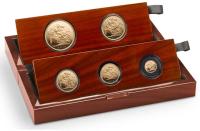
5 Coin Proof Set since 2009
total gold weight: 2.0598 oz
The Quarter-Sovereign was first issued in 2009. Since that same year, 5 coin sets are issued that include a Quintuple-Sovereign, Double-Sovereign, Sovereign, Half-Sovereign and Quarter-Sovereign. As always, the coins are encapsulated and a certificate of authenticity is included.
